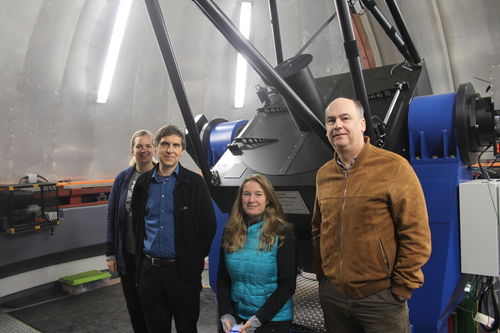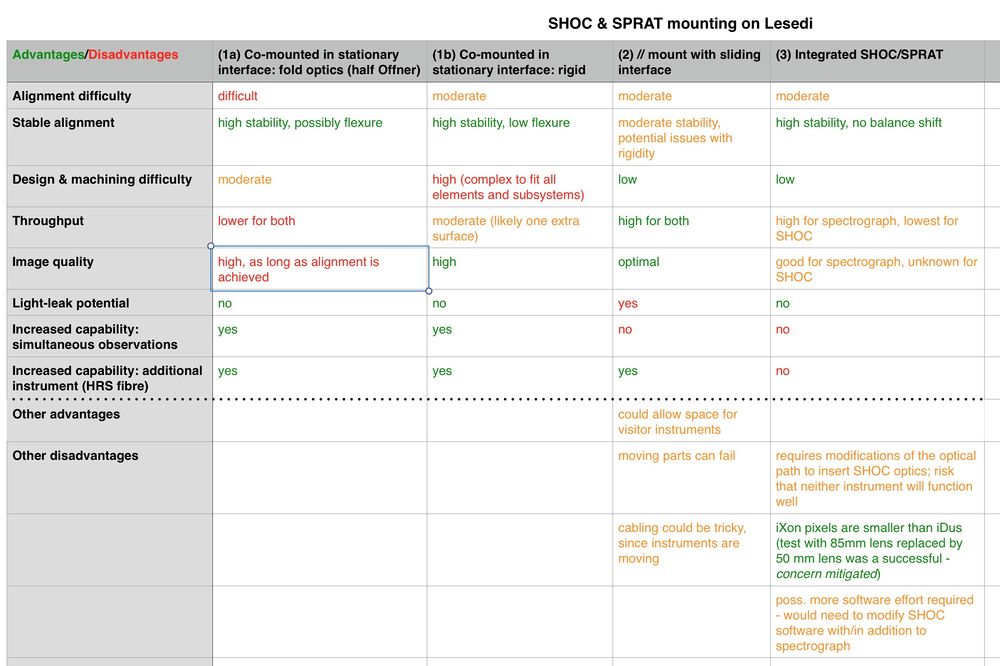Lesedi Project Wiki
- This wiki is for construction of a spectrograph on the 1-m Lesedi telescope in Sutherland. We anticipate future wikis for the user manual and for technical support.
- The SAAO and LJMU (Liverpool John Moores University) are collaborating on the project.
- The instrument is based on SPRAT (Spectrograph for Rapid Acquisition of Transients), which is currently operating robotically on the 2-m Liverpool Telescope on La Palma.
Project Team
Instrument PI: Iain Steele (LJMU; I.A.Steele@ljmu.ac.uk)
Instrument Scientists: Helen Jermak (h.e.jermak@ljmu.ac.uk)/ Andrjez Piascik (LJMU; A.S.Piascik@ljmu.ac.uk)
Mechanical Engineer: Stuart Bates (LJMU; S.D.Bates@ljmu.ac.uk)
Software Engineer: Chris Mottram (LJMU; C.Mottram@ljmu.ac.uk)
Data Pipeline: Marco Lam (LJMU; C.Y.Lam@ljmu.ac.uk)
Local Co-PIs: Amanda Sickafoose (amanda@saao.ac.za) & Hannah Worters (hannah@saao.ac.za)
Local Electronics Engineer: Hitesh Gajjar (hitesh@saao.ac.za)
Local Mechanical Engineesr:James O'Connor (joc@saao.ac.za) and Egan Loubser (egan@saao.ac.za)
Local Software Engineer: Carel van Gend (carel@saao.ac.za)
Documentation
- The link to the 2017 October 27 Skype kick-off presentation: https://www.dropbox.com/s/lcr54nkvtusdh69/SAAO-SPRAT-KICKOFF.pptx?dl=0 (includes references to the SPIE paper and Zej's thesis)
Notes from meetings
Notes from meeting on 1st Feb 2019
Combined Sprat/SHOC is way to go.
Working out from Nasmyth:
- "Inside" Nasymyth is autoguider. This can patrol half of the field of view, and will hopefully have a focus mechanism.
- Nasmyth mounting:
- James to provide details of this mounting as used on Wide Field Camera on opposite port.
- 1/4 of the field of view will be for a High Resolution Spectrograph (HRS) fibre feed
- 1/4 of the field of view with be for SPRAT/SHOC
- A cable wrap (copy of that on opposite port) will be provided. James to provide details.
- There is possibility of pneumatic supply
- Deployable calibration mirror (to feed flat/arc)
- Deployable slit
- Field Lens
- Collimator Lens
- FILTER SLIDES (3). Hopefully <50mm thickness. To house maybe 5 filters each. Note one filter will need to be order blocker (4000-8000 Angstroms) for SPRAT. James to design to fit to an interface in SPRAT.
- Grism Assembly
- Camera Lens and CCD.
General Design Points
- Filter slides need to be in collimated beam to avoid focus shifts
- Try and minimise cables on/off mount. So mount control computer with instrument. Note SHOC software requires GPS feed (serial; currently using serial to USB, Amanda to check latest GPS hardware).
- USB for camera rather than PCI Card
- Use existing SHOC CCD readout (via andor SDK)
- Use existing Apache Thrift infrastructure
- LJMU responsible for all mechanism control, including filter slides
- Use wiki to keep one version of documentation/files etc.
Actions:
- IAS: Check/modify optical design to make space for filter slides
- James: Provide details of mounting plate/wider field camera (STEP File); provide information on cable wrap being used on other port
- Carel: Provide details of SHOC software to Chris Mottram so he can try and built a local copy at LJMU
- Amanda: Look at trade off between deep depletion (higher red QE, higher dark current) and standard EMCCD
SHOC/SPRAT hybrid
- Point was raised that (rather than comount SHOC and this new spectrograph) we could use an iXon camera in the SPRAT system, add filter wheels, and effectively use it as SHOC when the slit, grating, and prisms are out of beam. The iXon has 1024 x 13-micron pixels as opposed to the iDus 1024 x 26-micron pixels. A test was performed at LT in the week of 15 Dec., in which the 85 mm f/1.8 camera lens was swapped out with a 50 mm Nikon f/1.4. The result from an arc was 7.70 Å/channel, central wavelength 6009.04 Å, range 4073.64 – 8018.33 Å. This range could be tweaked by tilting the camera slightly.
Some more details 50mmLensTest
- Point raised by Stu at 12 Feb. 2019 Skype about filter wheel insertion into collimated beam causing flexture. James thinks that if the design can stay within the original structure envelope, and we are smart about orientation, the current stiffness might suffice. Alternatives to consider are (1) mounting a filter wheel near the entrance to the instrument or (2) separate SPRAT/SHOC mountings, by removing SPRAT and disconnecting the camera to reattach on the port.

